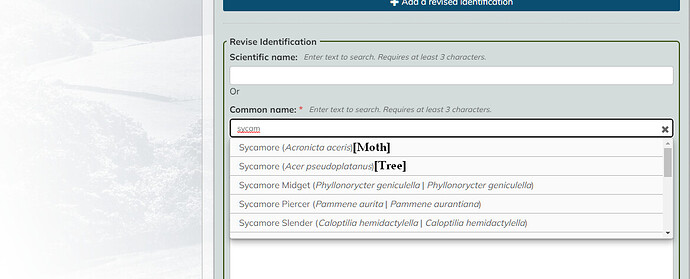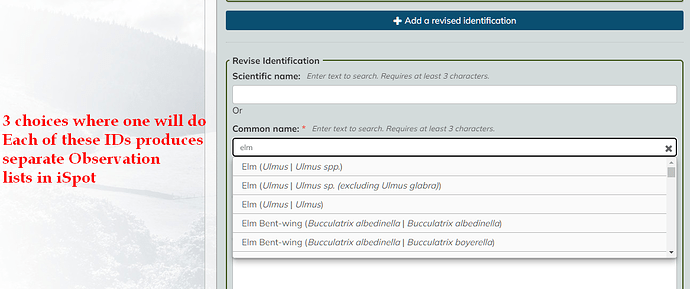Maybe Norwegian maple?
Actually its not clear how the user was able to select “sycamore (Acronicta aceris)”. Given the s of sycamore is lower case, I’m guessing that was hand-typed - but then you don’t get offered “Acronicta aceris” in the scientific selector.
Regardless - for instances where a common name can appear in two completely different groups, I think they need clarity (hence “Sycamore moth”).
I don’t think the user selected Acronicta aceris, he just typed sycamore - your code did the link.
So, are you going to try to fix it via my Wings&Prayers?
3 people have agreed there, leaving the ODD IDs on display
I could delete the “Sycamore (Acronicta aceris)” identification on your Wings & Prayers observation but would have to leave any impact it had on reputation alone. This is obviously the risk - there’s no undo!
“You’ve replied to @Chris_Valentine 3 times, did you know you could send them a personal message instead?” No I want other people to see the contents of the Thread, so
That’s not what’s wanted Chris.
I think we want the Menu to show the group where there might be confusion. This would prevent people adding the wrong ID - there are plenty of examples
If it means destroying my Observation or even reducing my reputation, I do not mind
But this is a wider issue than the Sycamore
You wrote " Changing the dictionary entry now should mean future identifications use the correct entry."
The whole Common name menu needs an overhaul
Of more concern is that there is likely to be data in other tables (for example frontend_users_reputation_history) that point to the identification record - and if I then delete that identification, the link is broken. Can open - Annelida everywhere.
Not exactly a ‘problem’ but an observer who saw a putative kelp gull couldn’t enter the sighting because it doesn’t appear to be in the species dictionary.
Please add a link - there will probably be an excellent reason.
Hi, dejayM
The post is at [A gull first. | Observation | UK and Ireland | iSpot Nature]
Never previously recorded from Britain and Ireland is a fairly good reason, though it’s arrival had been predicted.
Thanks.
It is not in the UK dictionary (of course).
Neither is the Nile Crocodile
If you want an illustrated Observation do it like this
It’s an easy process and it has been done a few time before - in fact there are TWO recent observations done like this (NOT by me) and NO-ONE has mentioned it
.
: I can talk you through it here ![]() (so everyone knows how it works)
(so everyone knows how it works)
There will be some frowning now that it is broadcast.
If there is an uproar, delete it!
Please make certain I know you have seen the dummy and so Ican delete it!
I have seen the dummy!
I am probably thicker than the proverbial ten planks, but I’m not sure how you did it!
the question is…would YOU like to do it?
If it creates a storm then it can be deleted OR we can stick to our guns as I think we should have the choice of Dictionaries or perhaps dump the UKSI in Favour of the Catalogue of Life - except that seaweeds are a laugh!
I have left the Demo for now, perhaps someone might even comment
Hi, dejayM
I don’t feel that it’s appropriate for me to ID the gull - it should be the finder.
In the unlikely event that I find a ‘first’ for the UK, I may come back to you.
That’s fine…I have deleted the Demo.
Another anomaly, not nearly as interesting as the Cape Gull (sorry). There are 6 options in the drop-down for Eristalis but they don’t all link up to all the observations of Eristalis. Luisa posted one here: Drone fly? | Observation | UK and Ireland | iSpot Nature
It has only 2 other observations, which is nuts. She noticed there was something wrong and queried it - I wouldn’t have noticed otherwise. I think this has happened with other species which have multiple occurrences in the drop-down. Can it be fixed?
we have been talking about this for years. It seems that the iSpot Browser is often at fault not always the NHM Index (Dictionary)
I think it is possible to amend the Drop-in menus @miked so that there is only ONE entry, perhaps several times via different common names, for ONE Scientific name. Tri-nominals ought to be accepted or removed but BOTH bi-nominal and tri-nominal should not appear.
All that’s happening is that we are confusing users and producing several DIFFERENT lists of Other Obs. See, for example, Plant of the month. That, of course, is an NHM issue (not to mention Taxonomists of course).
I still think that iSpot is a great testing ground for NHM Dictionary anomalies, so there needs to be much closer and visible co-operation with the Other Curator who, incidentally, has a Profile here Chris Raper | User | iSpot Nature
I’m not sure whether it is me or the dictionary but someone has posted a French-observed moth which is clearly the spotted sulphur. Normally referred to as Emmelia trabealis but Acontia trabealis is sometimes used. I cannot find an entry under any of the above three names so have been unable to provide an ID for the user. Unknown Moth | Observation | Global | iSpot Nature
lovely moth. I have commented in the Observation
the moth is here Spotted Sulphur (Acontia trabealis) (=Emmelia trabealis) - Suffolk Moths - The macro and micro moths of Suffolk.
Acontia trabealis (Scopoli, 1763)
.
Clearly in the Updated NHM (UKindex) (But not in the Global CoL)
Species Dictionary | Natural History Museum
and is Acontia trabealis in UK iSpot with NO? records?
The moth has been extinct in the UK for many years.


